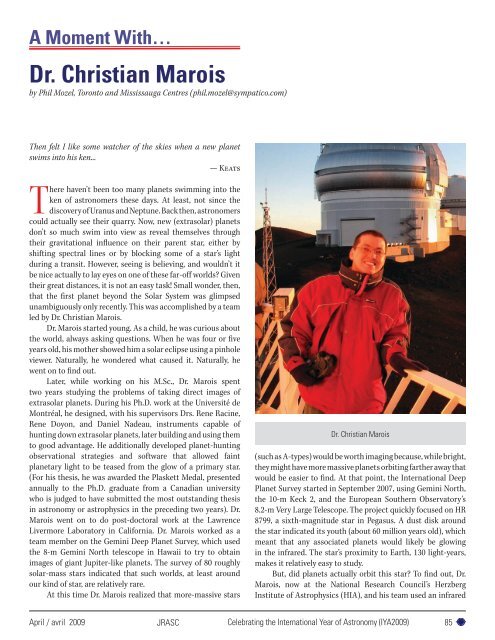Moment
insidethisissue - The Royal Astronomical Society of Canada
insidethisissue - The Royal Astronomical Society of Canada
You also want an ePaper? Increase the reach of your titles
YUMPU automatically turns print PDFs into web optimized ePapers that Google loves.
A <strong>Moment</strong> With…Dr. Christian Maroisby Phil Mozel, Toronto and Mississauga Centres (phil.mozel@sympatico.com)Then felt I like some watcher of the skies when a new planetswims into his ken...— KeatsThere haven’t been too many planets swimming into theken of astronomers these days. At least, not since thediscovery of Uranus and Neptune. Back then, astronomerscould actually see their quarry. Now, new (extrasolar) planetsdon’t so much swim into view as reveal themselves throughtheir gravitational influence on their parent star, either byshifting spectral lines or by blocking some of a star’s lightduring a transit. However, seeing is believing, and wouldn’t itbe nice actually to lay eyes on one of these far-off worlds? Giventheir great distances, it is not an easy task! Small wonder, then,that the first planet beyond the Solar System was glimpsedunambiguously only recently. This was accomplished by a teamled by Dr. Christian Marois.Dr. Marois started young. As a child, he was curious aboutthe world, always asking questions. When he was four or fiveyears old, his mother showed him a solar eclipse using a pinholeviewer. Naturally, he wondered what caused it. Naturally, hewent on to find out.Later, while working on his M.Sc., Dr. Marois spenttwo years studying the problems of taking direct images ofextrasolar planets. During his Ph.D. work at the Université deMontréal, he designed, with his supervisors Drs. Rene Racine,Rene Doyon, and Daniel Nadeau, instruments capable ofhunting down extrasolar planets, later building and using themto good advantage. He additionally developed planet-huntingobservational strategies and software that allowed faintplanetary light to be teased from the glow of a primary star.(For his thesis, he was awarded the Plaskett Medal, presentedannually to the Ph.D. graduate from a Canadian universitywho is judged to have submitted the most outstanding thesisin astronomy or astrophysics in the preceding two years). Dr.Marois went on to do post-doctoral work at the LawrenceLivermore Laboratory in California. Dr. Marois worked as ateam member on the Gemini Deep Planet Survey, which usedthe 8-m Gemini North telescope in Hawaii to try to obtainimages of giant Jupiter-like planets. The survey of 80 roughlysolar-mass stars indicated that such worlds, at least aroundour kind of star, are relatively rare.At this time Dr. Marois realized that more-massive starsDr. Christian Marois(such as A-types) would be worth imaging because, while bright,they might have more massive planets orbiting farther away thatwould be easier to find. At that point, the International DeepPlanet Survey started in September 2007, using Gemini North,the 10-m Keck 2, and the European Southern Observatory’s8.2-m Very Large Telescope. The project quickly focused on HR8799, a sixth-magnitude star in Pegasus. A dust disk aroundthe star indicated its youth (about 60 million years old), whichmeant that any associated planets would likely be glowingin the infrared. The star’s proximity to Earth, 130 light-years,makes it relatively easy to study.But, did planets actually orbit this star? To find out, Dr.Marois, now at the National Research Council’s HerzbergInstitute of Astrophysics (HIA), and his team used an infraredApril / avril 2009JRASCCelebrating the International Year of Astronomy (IYA2009)85
















